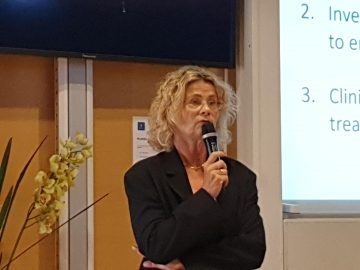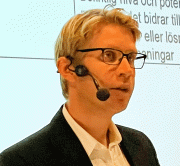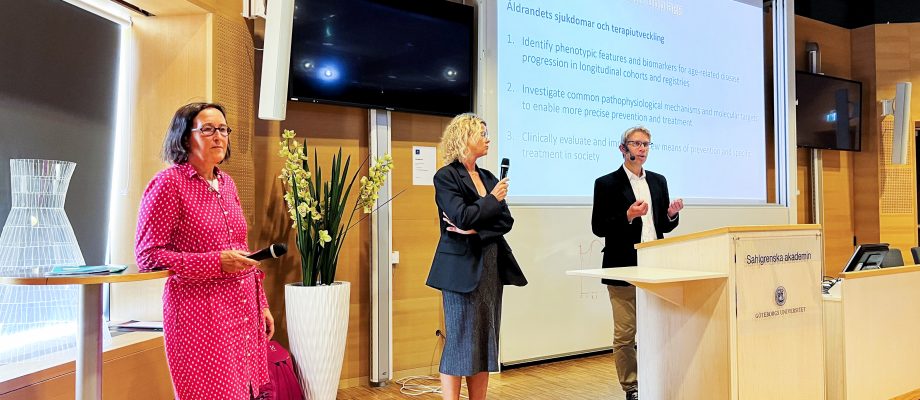FACULTY MEETING. Sahlgrenska Academy plans to propose a profile area in the university-wide efforts to develop five profile areas in which the University of Gothenburg may apply for funding. The proposed area for our faculty is “age-related diseases and therapy development”. At Thursday afternoon’s General Academy Meeting, the Faculty Board opened the floor a broad discussion.
In the 2021 spring budget bill, the Government proposed a new quality-based system for distributing direct government funding for research. The system is based on all higher education institutions in Sweden applying for several profile areas that will be determined after assessment by external experts. All higher education institutions are working on formulating the profile areas they will propose. It will be the high education institutions, and not the individual faculties, that will submit the applications.
An impossible task
The University of Gothenburg can apply for five profile areas, and Sahlgrenska Academy has been tasked with developing a common area: “age-related diseases and therapy development”.

“For a faculty of Sahlgrenska Academy’s breadth and size, singling out certain areas as particularly important and worth prioritizing is an almost impossible task. We have very good research in major fields and, in addition, complete academic environments with high-quality teaching, thanks in part to our researching teaching staff,” said Dean Agneta Holmäng, at the opening of the General Academy Meeting.
“Everyone involved in this work shares the belief in the importance of formulating an application that is not only impactful and credible but also as broad as possible, so that as many of the Academy’s researchers as possible can be included.”
A field for many
Professor Anders Rosengren gave a presentation on the faculty’s work with profile areas and the plan for how to design the application. The proposed profile area will consist of three tracks: 1) identify phenotypical traits and biomarkers for age-related disease progression in longitudinal cohorts and registers, 2) investigate common pathophysiological mechanisms and molecular goals to enable more exact prevention and treatment, and 3) clinically evaluate and implement new methods for prevention and specific treatment.
Rosengren stated that the proposed area covers a large part of current research at Sahlgrenska Academy, such as natural ageing, accelerated ageing, metabolic changes that are the common denominator for many of our major public diseases, and the degenerative changes and biomarkers characteristics of research in neuroscience. Because aging can be linked to so many diseases, much of Sahlgrenska Academy’s research is included in the proposed profile area.
“We can use the enormously varied and large cohorts available at Sahlgrenska Academy and develop them further through extended phenotyping and omics analysis and follow these cohorts longitudinally,” Rosengren said during his presentation.
Working group with broad representation

Anders Rosengren has been convener of the working group with representatives of researchers from every institute. The focus of the group is on the next generation of research heads. The members have been nominated by the various organizations and elected by staff: Lars Ny, Lars Palmqvist, Gustav Smith, Fredrik Bäckhed, Henrik Zetterberg, Linda Johansson, Per-Arne Svensson, Jan Derks and Johan Pauli. AstraZeneca is also represented in the working group (Cecilia Karlsson), and Vice Dean Lena Carlsson Ekander is co-opted to the group.
Throughout its work, the group has regularly held discussions with and sought feedback from the Faculty Board, the Heads of Departments Council and the Council for Research Questions (FOR). The group’s work follows a template, which is governed by external directives from the Swedish Research Council and internal instructions from the University’s Research Board. The application is to be in the form of a five-page research plan, where 30 selected publications are to demonstrate the faculty’s capacity in the proposed field. The application is due by September 19, after which the University’s joint process begins.
Separate application
“I think that there will be about ten proposals from the faculties that will be ranked and discussed by the research board, whereupon the Vice-Chancellor will decide which five profile areas the University will adopt. The research board will make an overall assessment. We are the only faculty doing a separate application, while the others are working with more cross-faculty proposals,” said Lena Carlsson Ekander, vice dean for research questions.
“It is very important for us to hear thoughts about the proposal, even though we are now in the final stages,” said Anders Rosengren, who also encouraged staff who have questions to contact him or Lena Carlsson Ekander.
A clear message during the meeting was that higher education institutions should not compete against each other with their profile areas. Each will be assessed individually within the chosen areas and by external experts. Two quality aspects will be assessed: scholarly quality and quality in collaboration.
No objections
Several of those present said that they thought the proposal looked very good. Eric Hanse feels that Sahlgrenska Academy’s proposal will have a good chance of adoption by the University of Gothenburg. It is likely that the funds allocated based on profile areas will not increase compared to today’s performance-based allocations, which Eric Hanse described as a disaster, but explained that he understood that it was now just a matter of accepting the situation.
Bo Söderpalm highlighted that there could be a risk in choosing such a broad area, that this might send a signal that we do not dare to identify a more narrowly defined area. Anders Rosengren responded that the working group has thought a lot about that risk and discussed the trade-offs of cutting-edge versus breadth extensively. Ultimately, the group’s conclusion was that the proposed broad profile area can also be innovative, where broad research at the faculty is given a new emphasis and a conceptual focus that benefits from our tradition of interdisciplinary work within Sahlgrenska Academy.
“We will do our best to make this as good as possible. It’s great that we can include the entire faculty and see new shared connections between research areas,” concluded Anders Rosengren.
BY: ELIN LINDSTRÖM











